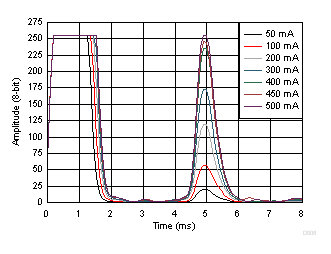SLAA732A February 2017 – April 2021 PGA460 , PGA460-Q1
5.3 Current Limit
A current limit is most relevant for transformer driven modules because a transformer-driven solution typically requires higher drive currents through the primary windings as compared to the bridge-driven mode. However, depending on the transducer paired with the bridge driven solution, the current limit can still have an impact on maximum sound pressure level generated.
The example in Figure 5-3 shows that the transformer-driven solution is very sensitive to the current limit and approaches saturation near the 450 to 500-mA maximum limit offered by the PGA460 device. A smaller current limit also yields a shorter decay time and therefore has the benefit of a median current limit for short-to-mid range evaluation.
 Figure 5-3 Current Limit Increased from 50 mA to 500 mA
Figure 5-3 Current Limit Increased from 50 mA to 500 mA